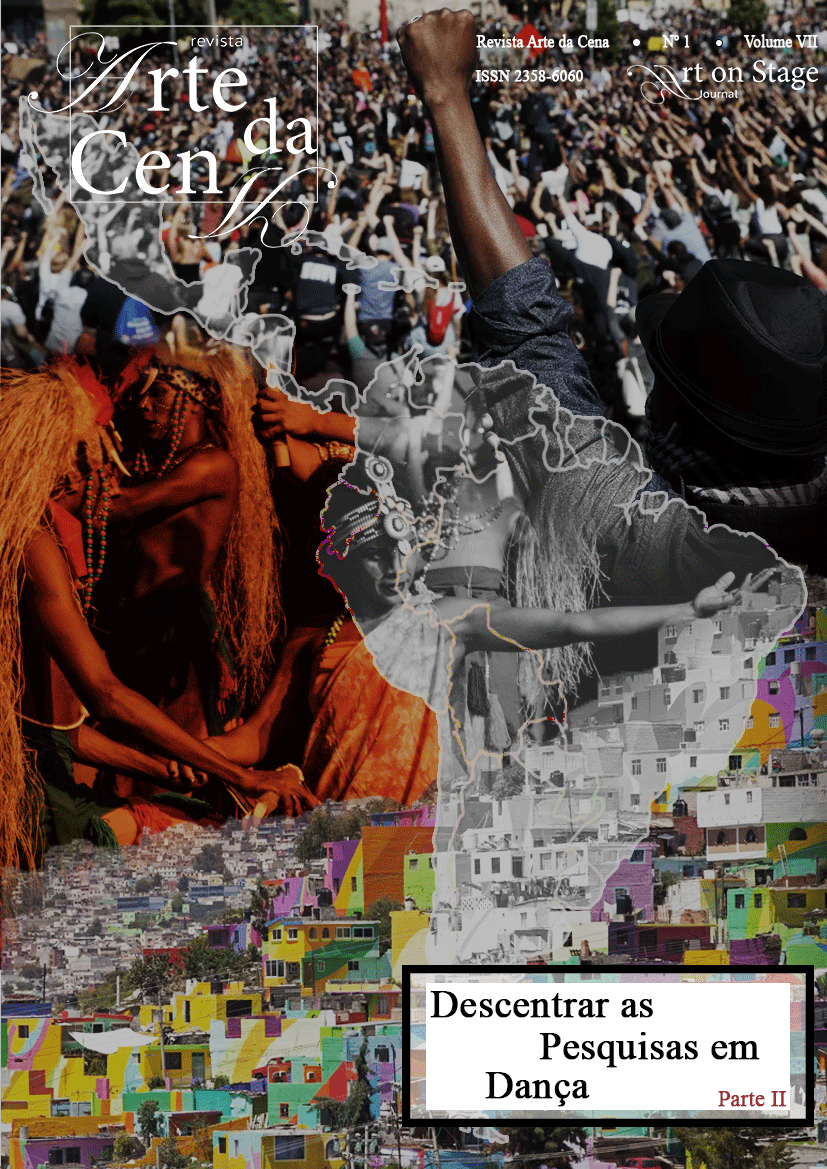Bodies of magic.
A look at the operation of dance and objects in the magical rite from the aspects of device, narrative and mediatization
DOI:
https://doi.org/10.5216/ac.v7i1.65666Abstract
The following work seeks to recognize the aspects that allow us to define the Magical Rite as a performative act, investigating the semi-anthropological configurations that result from the disposition of body movement, dance and the objects participating in the rite.
Our position for the observation agrees with the reflection of Levi Strauss in the sense that the physical is, at the same time, both a simple element of significance of a symbolism that overwhelms it, and the only means of verification of a reality whose multiple aspects cannot be caught out of it, in a synthetic form (1979) With it, we will echo the proposition that identifies the structuralist current: the symbols are more real than the object that they symbolize.
In this direction, it will be sought to pay attention mainly to the object level in different types of magic scenes, as objects fulfil a defined and systematized symbolic role, but are also variable and comparable. In relation to this aspect, we will investigate the functioning of the body and its aestesic and aesthetic expressiveness, as the nucleus of the ritual device.
We will observe the Magical Rite as a device inserted and sustained in the long history of mediatization, starting from the concept of narrative proposed by Fabbri (1999) and revised by the socio-semiotics, as well as notions such as that of the law of sympathy proposed by Frazer (1890) reformulated by Mauss (1902-1903) and then discussed by the Tensive Semiotics - whose position is that the exercise of some rhetorical figures are in line with the problems of cultural taxonomies, problems that are both lexicological, sociological and anthropological.
Downloads
References
BRIDGES, Esteban Lucas. Uttermost part of the Earth. London: Hodder and Stoughton, 1951.
COLOMBRES, Adolfo. Teoría transcultural del arte, hacia un pensamiento visual independiente. México: CONACULTA, 2014.
EASTWELL, Harry. Voodoo Death and the Mechanism for Dispatch of the Dying in East Arnhem, Australia. Virginia: Ed. American Anthropological Association, 1982.
EVANS-PRITCHARD, Edward. Witchcraft, oracles, and magic among the Azande. Oxford: Clarendon Press, 1937.
EVANS-PRITCHARD, Edward Ensayos de Antropología Social. Madrid: Siglo XXI Editores, 1990 [1974]
FABBRI, Paolo. El giro semiótico. Barcelona: Gedisa, 1999
FRAZER, James George . La rama dorada. Magia y religión. México D.F: Fondo de Cultura Económica, 2011 [1890]
GERSI, Douchan. Vudú, magia y brujería: sabidurías de lo invisible. Madrid: Biblioteca fundamental, 1994
GUSINDE, Martin. Los Selk’nam, vol. 1 de Los indios del Tierra del Fuego, traducción de Werner Hoffman. Buenos Aires: Centro Argentina de Etnología Americano, 1982
LEROI-GOURHAN, Andre. El gesto y la palabra. Caracas: Ediciones de la Universidad Central de Venezuela, 1971 [1964]
LEVI STRAUSS, Claude. El pensamiento salvaje. México: Fondo de Cultura Económico, 1964 [1962]
LEX, Barbara. Voodoo Death: New Thoughts on an Old Explanation. Estados Unidos: American Anthropologist vol. 76, 1974, p. 818-823.
MAUSS, Marcel. Sociologia y Antropología. Introducción a la obra de Marcel Mauss, Esbozo sobre una teoría general de magia, Madrid: Tecnos, 1979
MERQUIOR, José. Estètica de Lévi-Strauss- Sao Paulo: É Realizações Editora, 2013 [1975]
METRAUX, Alfred. Vudú. Buenos Aires: Ediciones Sur, 1963
SAN CRISTÓBAL, Úrsula ¿Acción, puesta en escena, evento o construcción audiovisual? Una breve introducción al concepto de performance en humanidades y en música. Cuadernos de música, artes visuales y artes escénicas. Colombia: 2018. Volumen 13 - 1. Disponible en: https://dialnet.unirioja.es/servlet/revista?codigo=14526
SIMONDON, Gilbert. El modo de existencia de los objetos técnicos. Buenos Aires: Prometeo Libros, 2007
VERÓN, Eliseo. La Semiosis Social 2: Ideas, Momentos, Interpretantes. Buenos Aires, Paidós, 2013
TAUSSIG, Michael. Viscerality, faith, and skepticism. Another theory of magic, en Hau: Journal of Ethnographic Theory 6 (3). Ed. University of Chicago, 2016, 453–483
TZVETAN, Todorov. Los dos principios del relato, en Introducción a la literatura fantástica. México DF: Editorial Coyoacán, 2016 [1970]
WARNER, W. Lloyd. A Black Civilization. A Social Study of an Australian Tribe. New York: Harper & Row, 1958
YOUNG-EISENDRATH, Polly y DAWSON, Terence. Introducción a Jung. Madrid: Akal Cambridge, 2003 [1999]
ZILBERBERG, Claude. Semiótica Tensiva. Lima: Fondo Editorial Universidad, 2016 [2006]
Downloads
Published
How to Cite
Issue
Section
License
Copyright (c) 2021 Susana Temperley

This work is licensed under a Creative Commons Attribution-NonCommercial 4.0 International License.
The Art on Stage Journal uses the Creative Commons - Attribution-Non-Commercial 4.0 International license as a basis for transferring rights, for open access journals (Open Archives Initiative - OAI).
Authors who publish in this journal agree with the following terms:
1) Authors retain the copyright and grant the Art on Stage Journal the right to first publication, with the work simultaneously licensed under the Creative Commons Attribution Non Commercial License.
2) Authors are authorized to assume additional contracts separately, for non-exclusive distribution of the version of the work published in this Journal (eg, publishing in institutional repository or as a book chapter), with acknowledgment of authorship and initial publication in this journal.
3) Authors are allowed and encouraged to publish and distribute their work online (eg in institutional repositories or on their personal page) at any point before or during the editorial process, provided that the reference to the place of publication is cited, that is, the electronic address / reference of Art on Stage Journal.
4) The authors of the works published in the Art on Stage are expressly responsible for their content.
5) Authors will not be paid for publication of works in the Art on Stage Journal.



